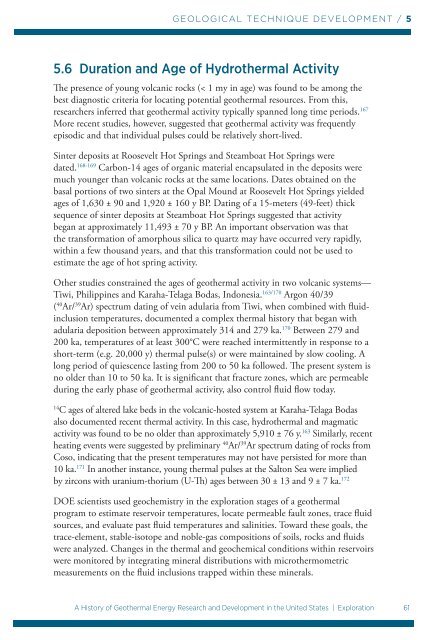A History of Geothermal Energy Research and Development in the ...
A History of Geothermal Energy Research and Development in the ...
A History of Geothermal Energy Research and Development in the ...
Create successful ePaper yourself
Turn your PDF publications into a flip-book with our unique Google optimized e-Paper software.
GEOLOGICAL TECHNIQUE DEVELOPMENT / 5<br />
5.6 Duration <strong>and</strong> Age <strong>of</strong> Hydro<strong>the</strong>rmal Activity<br />
The presence <strong>of</strong> young volcanic rocks (< 1 my <strong>in</strong> age) was found to be among <strong>the</strong><br />
best diagnostic criteria for locat<strong>in</strong>g potential geo<strong>the</strong>rmal resources. From this,<br />
researchers <strong>in</strong>ferred that geo<strong>the</strong>rmal activity typically spanned long time periods. 167<br />
More recent studies, however, suggested that geo<strong>the</strong>rmal activity was frequently<br />
episodic <strong>and</strong> that <strong>in</strong>dividual pulses could be relatively short-lived.<br />
S<strong>in</strong>ter deposits at Roosevelt Hot Spr<strong>in</strong>gs <strong>and</strong> Steamboat Hot Spr<strong>in</strong>gs were<br />
dated. 168-169 Carbon-14 ages <strong>of</strong> organic material encapsulated <strong>in</strong> <strong>the</strong> deposits were<br />
much younger than volcanic rocks at <strong>the</strong> same locations. Dates obta<strong>in</strong>ed on <strong>the</strong><br />
basal portions <strong>of</strong> two s<strong>in</strong>ters at <strong>the</strong> Opal Mound at Roosevelt Hot Spr<strong>in</strong>gs yielded<br />
ages <strong>of</strong> 1,630 ± 90 <strong>and</strong> 1,920 ± 160 y BP. Dat<strong>in</strong>g <strong>of</strong> a 15-meters (49-feet) thick<br />
sequence <strong>of</strong> s<strong>in</strong>ter deposits at Steamboat Hot Spr<strong>in</strong>gs suggested that activity<br />
began at approximately 11,493 ± 70 y BP. An important observation was that<br />
<strong>the</strong> transformation <strong>of</strong> amorphous silica to quartz may have occurred very rapidly,<br />
with<strong>in</strong> a few thous<strong>and</strong> years, <strong>and</strong> that this transformation could not be used to<br />
estimate <strong>the</strong> age <strong>of</strong> hot spr<strong>in</strong>g activity.<br />
O<strong>the</strong>r studies constra<strong>in</strong>ed <strong>the</strong> ages <strong>of</strong> geo<strong>the</strong>rmal activity <strong>in</strong> two volcanic systems—<br />
Tiwi, Philipp<strong>in</strong>es <strong>and</strong> Karaha-Telaga Bodas, Indonesia. 163/170 Argon 40/39<br />
( 40 Ar/ 39 Ar) spectrum dat<strong>in</strong>g <strong>of</strong> ve<strong>in</strong> adularia from Tiwi, when comb<strong>in</strong>ed with fluid<strong>in</strong>clusion<br />
temperatures, documented a complex <strong>the</strong>rmal history that began with<br />
adularia deposition between approximately 314 <strong>and</strong> 279 ka. 170 Between 279 <strong>and</strong><br />
200 ka, temperatures <strong>of</strong> at least 300°C were reached <strong>in</strong>termittently <strong>in</strong> response to a<br />
short-term (e.g. 20,000 y) <strong>the</strong>rmal pulse(s) or were ma<strong>in</strong>ta<strong>in</strong>ed by slow cool<strong>in</strong>g. A<br />
long period <strong>of</strong> quiescence last<strong>in</strong>g from 200 to 50 ka followed. The present system is<br />
no older than 10 to 50 ka. It is significant that fracture zones, which are permeable<br />
dur<strong>in</strong>g <strong>the</strong> early phase <strong>of</strong> geo<strong>the</strong>rmal activity, also control fluid flow today.<br />
14<br />
C ages <strong>of</strong> altered lake beds <strong>in</strong> <strong>the</strong> volcanic-hosted system at Karaha-Telaga Bodas<br />
also documented recent <strong>the</strong>rmal activity. In this case, hydro<strong>the</strong>rmal <strong>and</strong> magmatic<br />
activity was found to be no older than approximately 5,910 ± 76 y. 163 Similarly, recent<br />
heat<strong>in</strong>g events were suggested by prelim<strong>in</strong>ary 40 Ar/ 39 Ar spectrum dat<strong>in</strong>g <strong>of</strong> rocks from<br />
Coso, <strong>in</strong>dicat<strong>in</strong>g that <strong>the</strong> present temperatures may not have persisted for more than<br />
10 ka. 171 In ano<strong>the</strong>r <strong>in</strong>stance, young <strong>the</strong>rmal pulses at <strong>the</strong> Salton Sea were implied<br />
by zircons with uranium-thorium (U-Th) ages between 30 ± 13 <strong>and</strong> 9 ± 7 ka. 172<br />
DOE scientists used geochemistry <strong>in</strong> <strong>the</strong> exploration stages <strong>of</strong> a geo<strong>the</strong>rmal<br />
program to estimate reservoir temperatures, locate permeable fault zones, trace fluid<br />
sources, <strong>and</strong> evaluate past fluid temperatures <strong>and</strong> sal<strong>in</strong>ities. Toward <strong>the</strong>se goals, <strong>the</strong><br />
trace-element, stable-isotope <strong>and</strong> noble-gas compositions <strong>of</strong> soils, rocks <strong>and</strong> fluids<br />
were analyzed. Changes <strong>in</strong> <strong>the</strong> <strong>the</strong>rmal <strong>and</strong> geochemical conditions with<strong>in</strong> reservoirs<br />
were monitored by <strong>in</strong>tegrat<strong>in</strong>g m<strong>in</strong>eral distributions with micro<strong>the</strong>rmometric<br />
measurements on <strong>the</strong> fluid <strong>in</strong>clusions trapped with<strong>in</strong> <strong>the</strong>se m<strong>in</strong>erals.<br />
A <strong>History</strong> <strong>of</strong> <strong>Geo<strong>the</strong>rmal</strong> <strong>Energy</strong> <strong>Research</strong> <strong>and</strong> <strong>Development</strong> <strong>in</strong> <strong>the</strong> United States | Exploration 61

















